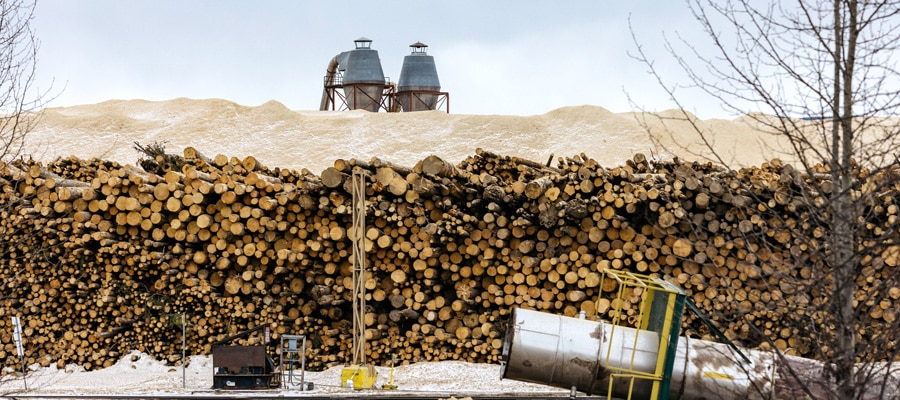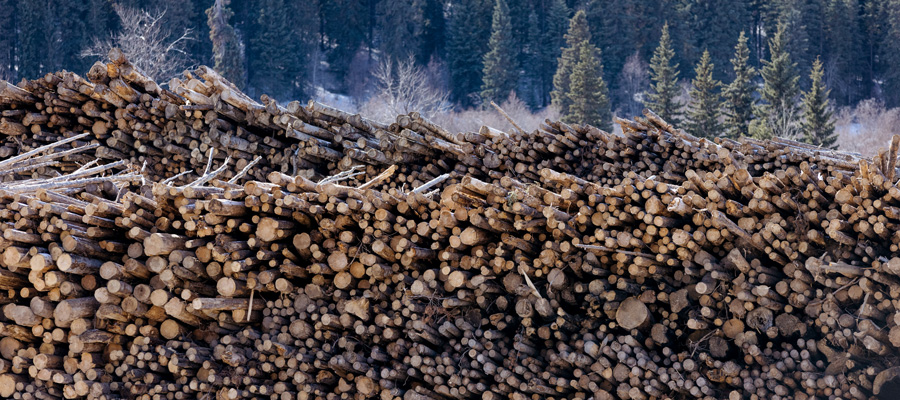Burns Lake looks to wood pellets
BC became prosperous on the basis of its resource industries. But today further development of resources is running into wall of climate policy. Good climate policies increasingly in conflict with old industrial policies. In spite of some small moves on the climate front from Victoria, a resource extraction mindset still dominates the corridors of power.
A new “greener” face of resource extraction is in bioenergy, the conversion of plant matter into usable energy. On the surface, this looks good because it is not combusting fossil fuels, but as Dave Neads points out below, this practice is far from green. Dave is a forestry consultant specializing in forest carbon issues. He lives in the west Chilcotin near Anahim Lake, in the central interior.
New Pellet Plant for Burns Lake
By Dave Neads
Just think of it. Clearcutting central interior B.C forests, turning the trees into pellets and shipping them halfway around the globe to be burned by heavy industrial polluters in Europe. These companies then claim carbon emissions reduction credits, even though the whole process actually increases CO2 emissions substantially. Bizarre.
The problem is an international one. Under current International Panel of Climate Change (IPCC) ruling, forest woody materials are classed as carbon neutral because the trees eventually pull the carbon back into the forest to grow new trees. Until this ruling is changed, the insanity of burning B.C interior forests in Europe will continue to be counted as neutral.
It may be true, under some conditions, planting and harvesting short rotation crops, maybe coppicing willows, maybe farming of grasses, even special short rotation poplars, may approach neutrality if you exclude the processing. This has not been done on a commercial viable scale as yet, but it is demonstrable under experimental conditions.
The problem is the application of this experimental logic to long rotation temperate forest ecosystems in the B.C interior. In fact, burning these forests makes the global climate change problem worse, much worse.
For those who are interested, here are some numbers: 440,000 tonnes of pellets will be produced annually by the new Burns lake pellet factory.
To get 444,000 tonnes of pellets you need to cut down about 530,000 tonnes of wood. This is because 20 percent or more of the wood cut down never makes it to town. Limbs, tops, coarse woody debris and really defective trees are left on the cut block to either be burned or to rot.
Leaving this carbon release aside, it is useful to focus on the 444,000 tonnes of manufactured wood pellets.
Wood is about 50% carbon. So 444,000 tonnes of wood contains approximately 222,000 tonnes of carbon. Allowing for a nominal moisture content of 20% , the actual carbon in the material is about 177,600 tonnes. When this carbon is burned it will produce 639,000 tonnes of CO2. (The ratio of CO2 to C is 3.6)
Back to the clearcut. On average there is 2 cubic metres of wood in a tonne. So 530,000 tonnes of wood is about 265, 000 cubic metres. On a median site as per analysis there will be 150 metres of wood per hectare. So the 265,000 cubic metres will need to be obtained by clearcutting 1,766 hectares of forest.
Now for the Carbon Neutrality part.
For the first 8 to 10 years, on average, a clearcut, complete with the new growth, is a net source of CO2.
After that, while rates vary by decade, the uptake over the cycle will be about 1 tonne of C per hectare per year. The issue here is volume replacement, not rate; the two are often confused. While younger trees do absorb C at a faster rate than older trees, it is the total volume of C sequestered in stand that counts. To replace the total volume is the necessary target, no matter what the rate.
The forest clearcuts totalling 1,766 hectares will need 110 years to pull the amount of C released when the forests removed and burned. There is no way around this. Some companies claim that “managed” stands will lower this number to as low as 80 years. However, this is not proven and even if the money is found to do pre thinning, fertilizing and commercial thinning, the increase in sequestration will be minimal. Even if the money is found , and optimal conditions are met, 80 years is still a long time.
What this means is that the C released by burning pellets to day will not be taken out of the atmosphere by new forest until at least the year 2100. This frontier continually advances. Pellets burned un 2011 will not be neutralized until 2101 and so on. This process of “moving carbon around” will not reach full circle until we have been burning pellets for 110 years.
But this about a lot more than just the cutting down of trees and burning them as pellets.
All of the following add to the C emissions problem as part of the industrial pellet production process. The actual logging, the making of the pellets, especially the use of natural gas fired kilns to dry the chips, the transport of pellets, the use of cargo ships which burn the most polluting low grade oil on the planet, for transport to Europe … all these parts of the manufacturing procedure are additional CO2 emissions to the burning of the wood.
The point is that because these emissions are external to the forest ecosystem, they can never, repeat, never be re-absorbed by the forest.
On top of this problem there effects of habitat alteration, loss of species diversity, soil disturbance and the loss of that forest landbase to sequester C over the next century if left alone have to be taken into account. Yes the beetle altered forest is a net source of C at the moment, however this phase will not last more than 30 years. As well, the current net emissions from the beetle altered forest are far, far, less then the emissions created by the clear cutting and conversion described above.
Finally, where will the 444,000 tonnes of wood come from in 10 or 15 years when the beetle wood runs out? Will a future government close down a successful business, lay off 20 or more people to save logging and chipping green forest to satisfy the market?
Bottom line: the pellet industry is not carbon neutral, it greatly increases CO2 emissions.
Kick the Carbon habit.
Topics: Climate change & energy policy


